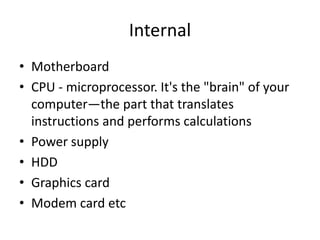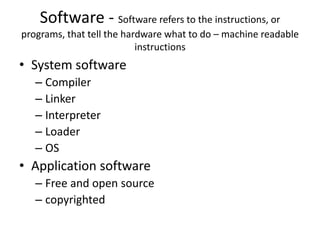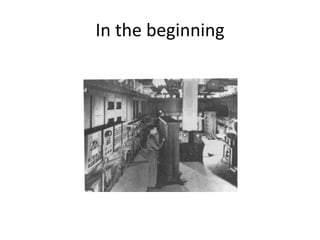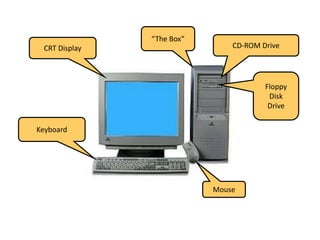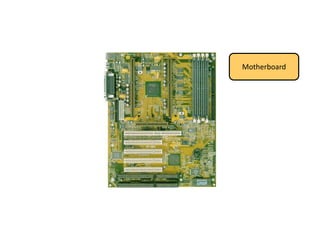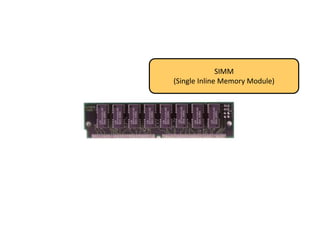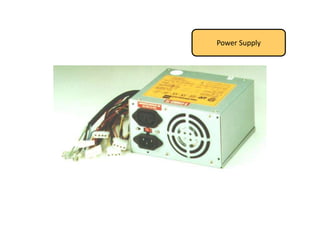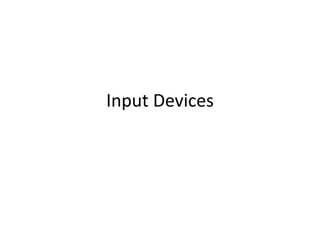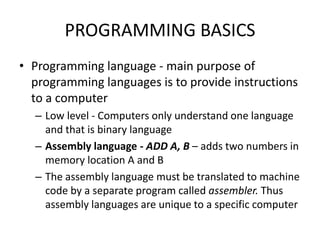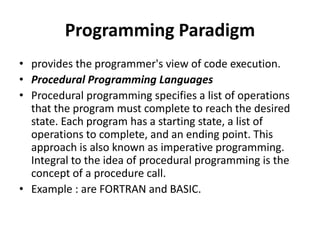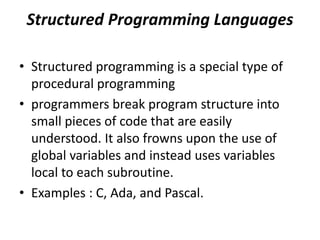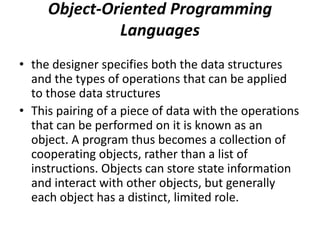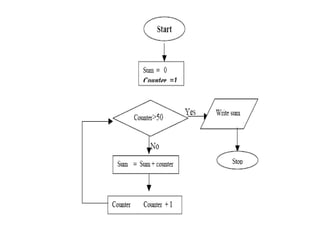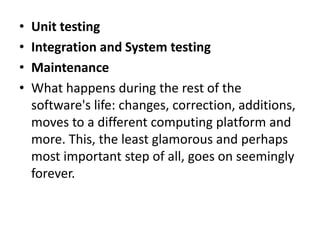Introduction to computer programming
- 1. INTRODUCTION TO COMPUTER PROGRAMMING Dr. SANGHEETHAA.S ASST.PROFESSOR DEPT . OF ELECTRICAL AND COMPUTER ENGG
- 2. INTRODUCTION • COMPUTER – WHAT IS A COMPUTER? – PARTS OF A COMPUTER? - HARDWARE INTERNAL EXTERNAL -SOFTWARE SYSTEM APPLICATION
- 3. COMPUTER • AN ELECTRONIC DEVICE • Helps us to solve problems according to a set of instructions, or programs • To do our work fast, easy • Saves time and energy • Can hear music, watch movies, paint pictures, solve complex problems, entertainment, infotainment, etc..
- 4. Hardware - Hardware refers to the parts of a computer that you can see and touch, including the case and everything inside it • External – Monitor – Printer – Scanner – Speaker – Microphone – Mouse – Keyboard etc
- 5. Internal • Motherboard • CPU - microprocessor. It's the "brain" of your computer—the part that translates instructions and performs calculations • Power supply • HDD • Graphics card • Modem card etc
- 6. Software - Software refers to the instructions, or programs, that tell the hardware what to do – machine readable instructions • System software – Compiler – Linker – Interpreter – Loader – OS • Application software – Free and open source – copyrighted
- 8. CRT Display Keyboard Mouse “The Box” CD-ROM Drive Floppy Disk Drive
- 9. Motherboard
- 11. SIMM (Single Inline Memory Module)
- 13. Power Supply
- 14. Schematic Diagram of a Personal Computer...
- 16. Output Devices
- 18. Input Devices
- 20. Tutorial • What are the types of computers? • What are the uses of computers? • What are the input devices you know? • Write about the working of the input devices? • Write about the working of output devices?
- 21. PROGRAMMING BASICS • Programming language - main purpose of programming languages is to provide instructions to a computer – Low level - Computers only understand one language and that is binary language – Assembly language - ADD A, B – adds two numbers in memory location A and B – The assembly language must be translated to machine code by a separate program called assembler. Thus assembly languages are unique to a specific computer
- 22. High level • High-level languages are more English-like and, therefore, make it easier for programmers to "think" in the programming language. High-level languages also require translation to machine language before execution. This translation is accomplished by either a compiler or an interpreter. Compilers translate the entire source code program before execution. Interpreters translate source code programs one line at a time. • FORTRAN (FORmula TRANslator), BASIC (Bingers All Purpose Symbolic Instruction Code), PASCAL, C, C++, Java are some examples of high-level languages.
- 23. Programming Paradigm • provides the programmer's view of code execution. • Procedural Programming Languages • Procedural programming specifies a list of operations that the program must complete to reach the desired state. Each program has a starting state, a list of operations to complete, and an ending point. This approach is also known as imperative programming. Integral to the idea of procedural programming is the concept of a procedure call. • Example : are FORTRAN and BASIC.
- 24. Structured Programming Languages • Structured programming is a special type of procedural programming • programmers break program structure into small pieces of code that are easily understood. It also frowns upon the use of global variables and instead uses variables local to each subroutine. • Examples : C, Ada, and Pascal.
- 25. Object-Oriented Programming Languages • the designer specifies both the data structures and the types of operations that can be applied to those data structures • This pairing of a piece of data with the operations that can be performed on it is known as an object. A program thus becomes a collection of cooperating objects, rather than a list of instructions. Objects can store state information and interact with other objects, but generally each object has a distinct, limited role.
- 26. Algorithm • An algorithm is defined as a step-by-step sequence of instructions that must terminate and describe how the data is to be processed to produce the desired outputs. • Simply, algorithm is a sequence of instructions. • Algorithms are a fundamental part of computing.
- 27. Tools – to document program logic • flowcharts, structured chart, and Pseudocode • Pseudocode (derived from pseudo and code) is a compact and informal high-level description of a computer algorithm that uses the structural conventions of programming languages, but typically omits detailes such as subroutines, variables declarations and system-specific syntax.
- 28. Example: • Original Program Specification: • Write a program that obtains two integer numbers from the user. It will print out the sum of those numbers. • Pseudocode: • Prompt the user to enter the first integer Prompt the user to enter a second integer Compute the sum of the two user inputs Display an output prompt that explains the answer as the sum Display the result
- 29. Structured Charts • Structured chart depicts the logical functions to the solution of the problem using a chart. It provides an overview that confirms the solution to the problem without excessive consideration to detail. It is high-level in nature. • Example: Write a program that asks the user to enter a temperature reading in centigrade and then prints the equivalent Fahrenheit value.
- 30. Example centigard centigard CelsusToFarh (main func) InPutCen CalcFar OutPutFar Fahrenheit
- 31. Flowchart • A flowchart (also spelled flow-chart and flow chart) is a schematic representation of an algorithm or a process . The advantage of flowchart is it doesn’t depend on any particular programming language, so that it can used, to translate an algorithm to more than one programming language. Flowchart uses different symbols (geometrical shapes) to represent different processes. The following table shows some of the common symbols.
- 32. Symbols used in a flow chart
- 34. • Example 1: - Draw flow chart of an algorithm to add two numbers and display their result. • Algorithm description • Read the rules of the two numbers (A and B) • Add A and B • Assign the sum of A and B to C • Display the result ( c)
- 35. Start End Read A, B C= A+B Print C
- 36. Example 2: Write an algorithm description and draw a flow chart to check a number is negative or not. Algorithm description. 1/ Read a number x 2/ If x is less than zero write a message negative else write a message not negative
- 37. • Example 3: - Write the algorithmic description and draw a flow chart to find the following sum. • Sum = 1+2+3+…. + 50 • Algorithmic description • 1. Initialize sum too and counter to 1 – If the counter is less than or equal to 50 • – • Add counter to sum – • Increase counter by 1 – • Repeat step 1.1 – Else • • Exit • • 2. Write sum
- 39. System Development Life Cycle (SDLC) • The Systems Development Life Cycle (SDLC) is a conceptual model used in project management that describes the stages involved in a computerized system development project from an initial feasibility study through maintenance of the completed application.
- 40. Feasibility study • The first step is to identify a need for the new system. components: • Organizational Feasibility – How well the proposed system supports the strategic objectives of the organization. • Economic Feasibility – Cost savings – Increased revenue – Decreased investment – Increased profits • Technical Feasibility – Hardware, software, and network capability, reliability, and availability • Operational Feasibility – End user acceptance – Management support – Customer, supplier, and government requirements
- 41. Requirements analysis • Requirements analysis is the process of analyzing the information needs of the end users, the organizational environment, and any system presently being used, developing the functional requirements of a system that can meet the needs of the users. • Also, the requirements should be recorded in a document, email, user interface storyboard, executable prototype, or some other form.
- 42. Designing solution • After the requirements have been determined, the necessary specifications for the hardware, software, people, and data resources, and the information products that will satisfy the functional requirements of the proposed system can be determined.
- 43. Testing designed solution • A smaller test system is sometimes a good idea in order to get a “proof-of-concept” validation prior to committing funds for large scale fielding of a system without knowing if it really works as intended by the user.
- 44. Implementation • The real code is written here. Systems implementation is the construction of the new system and its delivery into production or day- to-day operation. • The key to understanding the implementation phase is to realize that there is a lot more to be done than programming. Implementation requires programming, but it also requires database creation and population, and network installation and testing.
- 45. • Unit testing • Integration and System testing • Maintenance • What happens during the rest of the software's life: changes, correction, additions, moves to a different computing platform and more. This, the least glamorous and perhaps most important step of all, goes on seemingly forever.





